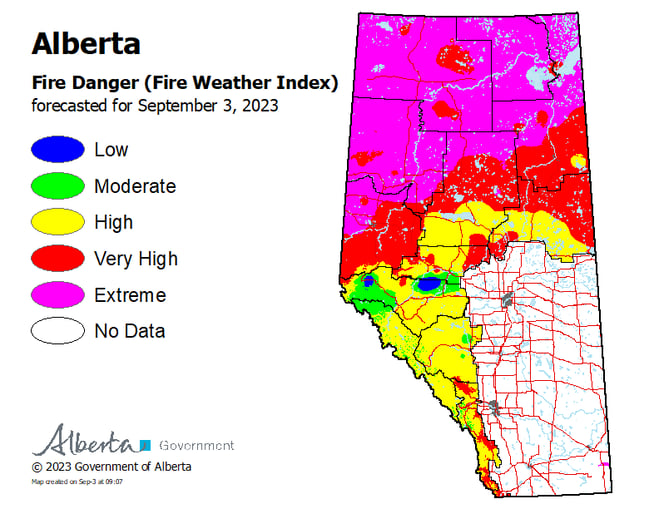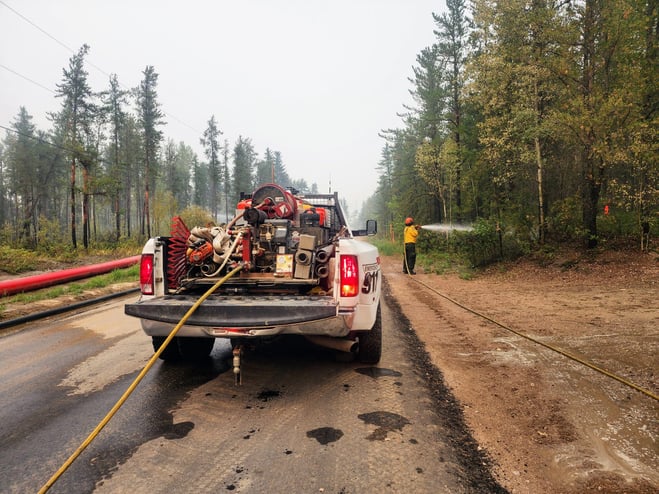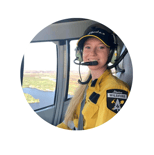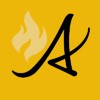
WILDFIRE DANGER
The wildfire danger is VERY HIGH within the Fort McMurray Forest Area.
A fire advisory remains in effect for the Fort McMurray Forest Area. See details below.
Please be very cautious when spending time outdoors this long weekend, as conditions are dry and windy. Wildfires can ignite easily and spread quickly.
Report wildfires immediately by calling 310-FIRE (3473).

EVACUATION ORDERS
Highway 5 is currently closed due to wildfire activity. Click here for more highway closure information.
The Regional Municipality of Wood Buffalo (RMWB) has declared a state of local emergency and issued an evacuation order for the community of Fort Fitzgerald. Click here for more information.
The Chief and Council of Smith's Landing First Nation has declared a state of local emergency and issued an evacuation order. Click here for more information.
The Town of Fort Smith has declared a state of local emergency and issued an evacuation order for residents within the municipality and surrounding areas. Click here for more information.
For information on Northwest Territories evacuations click here.
For more information and related links, please see MNZ003 below.
SMOKY CONDITIONS
Due to the numerous wildfires in western Canada, smoky conditions will continue. Anyone with health concerns should visit Alberta Health Services or call 811 for health advice from Alberta Health Link. Before travelling check 511 Alberta for information the latest road conditions or closures. Visit Fire Smoke Canada to see where the smoke is coming from and to view wildfires on a map, download the AB Wildfire Status App or visit the Alberta Wildfire Status Dashboard.
WILDFIRE OF NOTE
Wood Buffalo Complex (previously Parks Canada Fire 7, Alberta Wildfire MNZ003, and NWT SS069)
%20-%20Katie%20Ellsworth.jpg?width=2268&height=2267&name=20230902_140019(0)%20-%20Katie%20Ellsworth.jpg) Pockets of high fire activity were observed on pockets of the Wood Buffalo Complex wildfire yesterday (September 2, 2023).
Pockets of high fire activity were observed on pockets of the Wood Buffalo Complex wildfire yesterday (September 2, 2023).
Click here to see the most recent map.
The Wood Buffalo Complex remains at an estimated 474,114 hectares in size and is classified as out of control, which means that the fire is still burning and is expected to grow in size.
The wildfire remains 3.4 south of Fort Smith, NWT and 3.1 km south of Fort Fitzgerald, AB. It is now approximately 0.3 km from Thebacha, NWT.
Firefighters use multiple tools to measure distances and sizes depending on visibility, smoke and availability of aircraft and drones. These tools have various accuracies to measure distance and are subject to change
This wildfire was detected on May 28 in Wood Buffalo National Park and was determined to be caused by lightning. The Wood Buffalo Complex is being managed under unified command by the Government of Northwest Territories, Parks Canada, and Alberta Wildfire from the incident command post in Fort Smith.
There are currently 399 personnel which include 73 pieces of heavy equipment, 20 helicopters and 191 firefighters and structure protection personnel responding to the Wood Buffalo Complex. These numbers will fluctuate as personnel leave the incident for much needed rest and new personnel and resources arrive.
We urge members of the public to not return or visit evacuated communities. Firefighters and heavy equipment require extra room to move and need to focus on fire suppression. The few amenities that remain in the community, such as food and gas, are for first responders.
Today, winds are expected to calm down to 10 km/hr, gusting up to 25 km/hr from the west/northwest. The expected high is 17 C, with a relative humidity of 50 percent. There is a small chance of rain this evening (1-4 mm). Varying minimal amounts of rain fell overnight on some areas of the fire.
Strong, gusty winds coupled with clear skies led to a more challenging day on the wildfire yesterday. With no smoke or clouds to shield the fire from the sun’s heat, high to extreme fire activity was observed in a few areas of the Wood Buffalo Complex.
The most active area of the fire yesterday was the northeastern tip, closest to Thebacha. Activity picked up mid-morning and three parts of the fire made a run in this area, reaching Foxholes Road around 5 p.m. The fire was last observed to be along the Salt River. Heavy equipment and crews started the day in this area and worked as long as they could before wind speeds and fire activity were too intense to continue. Helicopters worked here all day, helping to slow down and limit spread of this active area. Structure protection specialists ran the sprinkler systems around Thebacha, before having to fall back into safety zones. This area of the fire was assessed strategically by air operations and determined to be beyond air tanker resources, meaning using them as a tactic yesterday would not have been effective.
Overnight, wildland-urban interface firefighters and structure protection specialists worked in the Thebacha area with fire trucks to patrol for embers and spot fires, along with a night crew. Fire specialists are assessing the Thebacha area of the fire today and will develop a revised plan for containment lines and strategies within the new growth that will include heavy equipment and on-the-ground firefighters.
Yesterday, along Hay Camp Road, south of Fort Fitzgerald, crews were working in the morning, but pulled out mid-afternoon due to unsafe conditions from higher fire activity and very gusty wind, downing large amounts of trees. Fire activity was pushing primarily to the east toward the Slave River, there were no reports of the fire breaching containment lines south of Fort Fitzgerald. Firefighters were in the Fort Fitzgerald area yesterday running the sprinkler systems on infrastructure. They did the same for the Salt River Day-Use Area in Wood Buffalo National Park and Smith’s Landing First Nation fish camp area.
There were small pockets of higher intensity fire in other areas that were successfully responded to by bucketing helicopters and crews on the ground. There was no substantial growth in these areas due to the focused, hard work of firefighters for the past two weeks.
Crews and heavy equipment worked along the main northeastern flank again yesterday, closest to Fort Smith. Firefighters are working on both sides of the flank, some off Highway 5 working eastward and some off Pine Lake Road working westward. Their goal is to suppress the fire off the lines they’re building. They’ll then target remaining hot spots and work to extinguish in and along the perimeter. Last night, a low-level, heat-sensing scan was conducted along 40 km of line. Firefighters have worked towards 50-ft extinguishment in a few areas of the main northeastern line and will use these scans to target the specific spots they revealed.
Firefighters today will continue extinguishment work along containment lines, heavy equipment will keep building on guards and helicopters will assist with bucketing as needed.
Message from communities
The Town of Fort Smith and Fort Fitzgerald have declared a STATE OF LOCAL EMERGENCY and it remains under an EVACUATION ORDER. The ORDER has been issued for public safety. If you have evacuated, please do not return. This is an active wildfire operation area and is dangerous for residents and first responders. You can also visit the Town of Fort Smith webpage for additional information.
Highway 5 is currently closed from Hay River to Fort Smith due to safety concerns and limited visibility. Click here for highway closure information.
Pine Lake Road from Bordertown to Peace Point remains CLOSED due to fire behaviour and active fire operations in the area.
Additional wildfire information
All other wildfires in Wood Buffalo National Park are being actively monitored and do not pose a risk to public safety at this time. Parks Canada will continue to monitor and action these wildfires as required. For more information visit Wood Buffalo National Park wildfire updates.
For information on other wildfires visit:
Wood Buffalo National Park wildfire updates
Northwest Territories fire information
Alberta Wildfire Status Dashboard
Report any wildfires or suspicious smoke in Alberta to 310-FIRE, in Northwest Territories to 1-877-NWTFIRE, and in Wood Buffalo National Park to 867-621-0136.

Structure protection specialists test high-volume sprinkler systems and work to increase humidity levels around communities, which lowers the risk of impact from fire (September 2, 2023).

FIRE ADVISORY IN EFFECT
A fire advisory is in effect for the entire Fort McMurray Forest Area due to continued hot and dry conditions which will increase the fire behaviour potential.
Under this advisory:
- Existing fire permits are still valid but may be suspended or cancelled if warm, dry weather continues
- The issuing or suspension of new permits is left to the discretion of a forest officer until conditions change
- Permits for the use of fireworks and exploding targets will not be issued.
Prohibited
Any burning without a valid fire permit, other than a campfire.
Allowed
- Safe wood campfires (including charcoal briquettes) in backcountry or random camping areas
- Safe wood campfires (including charcoal briquettes) on private lands and in provincial campgrounds
- Backyard fire pits
- Charcoal briquette barbeques
- Gas and liquid powered appliances (stoves and lanterns)
- Open flame oil devices (e.g., turkey deep fryers, tiki torches)
- Catalytic or infrared-style heaters
- Indoor wood fires
Remember to check the hot spots on your Off-Highway Vehicle (OHV) and remove debris before and after use.
Never leave a campfire unattended. Soak it, stir it and soak it again until cool to the touch to ensure it is extinguished.
If you see a wildfire, report it immediately by calling 310-FIRE.
The fire advisory will remain in effect until conditions improve.
FORT MCMURRAY WILDFIRE UPDATE
Since January 1, 2023 there have been 58 wildfires in the Fort McMurray Forest Area, burning a total of approximately 327,545 hectares (ha).
MWF021 was detected on May 27 and is located approximately 38 km south of Wood Buffalo National Park. This wildfire is classified as under control (UC) and is 14,760 ha in size. This wildfire was caused by lightning.
MWF023 was detected May 28 and is located near Birch Mountains Wildland Provincial Park. This wildfire is classified as under control (UC) and is 54,639 ha in size. This wildfire was caused by lightning.
MWF024 was detected May 28 and is located east of Marguerite River Wildland Provincial Park. This wildfire is classified as under control (UC) and is approximately 28,454 ha in size. This wildfire was caused by lightning.
MWF025 was detected May 28 and is located approximately 7 km north of Fort Chipewyan. This wildfire is classified as being held and is approximately 95,491 ha in size. This wildfire was caused by lightning.
This wildfire no longer poses a threat to the community of Fort Chipewyan, Allison Bay, Dog Head, or the Fort Chipewyan airport. Eighty per cent of the entire wildfire perimeter is controlled, which includes the entire south perimeter.
MWF038 was detected on June 29 and is located approximately 6 km north of the Slave Lake/Fort McMurray Forest Area border. This wildfire is classified as under control (UC) and is approximately 569 ha in size. This wildfire was caused by lightning.
MWF039 was detected on June 29 and is located within Birch Mountains Wildland Provincial Park but has crossed over into the Slave Lake Forest Area. This wildfire is classified as under control (UC) and is approximately 15,200 ha in size. This wildfire was caused by lightning.
MWF043 was detected on June 30 and is approximately 20 km southeast of Fort Fitzgerald. This wildfire is classified as being held and is approximately 108,556 ha in size. This wildfire was caused by lightning.
This wildfire is experiencing decreased fire growth and is not currently moving any closer to Fort Smith or Fort Fitzgerald.
Mutual-aid wildfires:
MNZ001 is located on the south edge of the Alberta/Wood Buffalo National Park border. This wildfire is classified as being held and is approximately 2,595 ha.
PROVINCIAL WILDFIRE UPDATE
ON ALERT
Fire lookouts are on high alert constantly watching for smoke and firefighters in helicopters are assessing potential sightings of wildfires, ready to respond to any new wildfires that may start.
Wildland firefighters urge everyone to be extremely cautious when out in the Forest Protection Area. Check your winter burns, and comply with fire bans and OHV restrictions.
.png?width=658&height=345&name=WF_Social-images%20(3).png)
CAMPFIRE SAFETY
Remember to check Alberta Fire Bans for fire advisories, bans or restrictions in your area or destination. If you are camping in a provincial or national park, check the rules and guidelines and be sure to follow them for your safety and the safety of other campers.
Safe wood campfires - should be within a metal, brick, or rock fire ring.
They are required to:
- be on rock, gravel, sand, or another non-combustible surface that extends at least one metre around the fire
- have a responsible person in attendance to keep fire under control at all times and extinguish before leaving
- have enough water on hand to extinguish the fire. Safe wood campfires on private lands include private land campgrounds and private land recreation areas.
Always let the fire burn down before you plan to extinguish it. Spread the embers within the fire pit, then add water or loose dirt and stir. Repeat until your campfire is cool to the touch. You should not be able to feel any heat from the ashes.
OHV SAFETY
If you plan on riding OHVs in the Forest Protection Area of Alberta, you can reduce the risk of your vehicle causing a wildfire by following these simple steps:
- Before you ride, clean out hot spots and remove debris from your machine.
- After riding through muskeg or tall grass, stop and remove any build-up from your machine.
- Carry firefighting equipment such as a small shovel, collapsible pail or fire extinguisher.
- Wash your OHV and keep it clean; do not wash in streams and creeks.
- Make sure your muffler and spark arrestor are working properly.
- Stop frequently. Take the time to knock debris from your machine’s hot spots. If the debris is smouldering, soak it, stir it, and soak it again to make sure it is extinguished.
For more information, see Off-highway vehicles: Wildfire prevention tips.
EXPLODING TARGETS AND FIREWORKS
The Forest and Prairie Protection Act and associated regulations applies to the shooting, ignition or detonation of exploding targets and fireworks on public lands and private lands located within the FPA.
A Forest Officer from the local forest area office may grant written permission to shoot, ignite or detonate exploding targets or fireworks in the FPA. Written permission of exploding targets and fireworks is based on current wildfire danger and managed on a case-by-case basis.
A fire advisory, restriction, ban or forest closure may prohibit or limit use of exploding targets and fireworks during high wildfire hazard situations within the FPA. Check Alberta Fire Bans or the mobile phone app for the latest information.
WILDFIRE DASHBOARD
The wildfire dashboard provides up-to-date wildfire information at the click of a button. This interactive tool displays important statistics on the number of active wildfires in the Forest Protection Area of Alberta, sizes, locations, suspected causes and more.
CONTACT

Websites:
- Alberta Wildfire
- Alberta Fire Bans
- FireSmart in Alberta
- Alberta Emergency Alerts
- Air Quality Health Index
- Wildfire Smoke and Your Health
- 511 Road Reports
- Emergency Preparation
Social media:
Join the conversation on
Apps:
Alberta Wildfire App for Apple or Android and Alberta Fire Bans App for Apple or Android.
